Your cart is currently empty!
Stay in Touch!
Get updates about new artwork and upcoming events.
Get updates about new artwork and upcoming events.
—
by
Fashion design has always been about more than just clothing. It is an ever-evolving expression of art, culture, and personal identity. Over the years, designers have sought new sources of inspiration to push the boundaries of what can be done with fabric, structure, and form. One of the most fascinating influences in modern fashion is origami, the Japanese art of paper folding. Origami, with its roots in precision and geometry, has become a significant tool for fashion designers, providing both structural techniques and aesthetic inspiration that transform ordinary garments into three-dimensional works of art.
For art collectors and interior designers, understanding the impact of origami on fashion design offers a unique perspective on how materials can be manipulated into wearable art, and how designers are pushing the limits of what garments can achieve through the adaptation of traditional art forms.
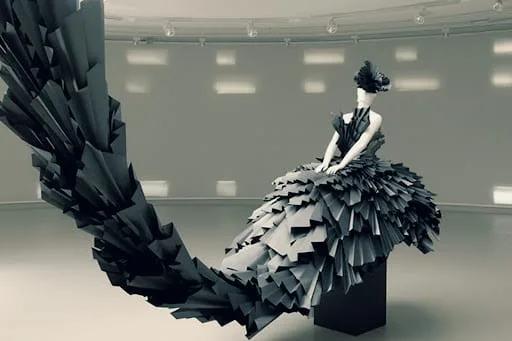
Origami, which originated in Japan, has a long history as a meditative and artistic practice, using precise folds to create complex shapes and forms out of a single sheet of paper. In fashion design, origami’s appeal lies in its ability to turn flat materials into sculptural masterpieces. Over the past few decades, more and more fashion designers have turned to origami to experiment with structure and silhouette, creating garments that are as much architectural as they are wearable.
The key principle of origami in fashion design is transformation—taking a flat surface, whether it’s fabric or paper, and transforming it into something that challenges our perception of two-dimensional vs. three-dimensional forms. This transformation can be seen in everything from runway-ready haute couture pieces to everyday garments and accessories.
One of the most significant ways that origami has influenced fashion design is through its structural techniques. The principles of folding and pleating, which are central to origami, have been adapted to create garments that have volume, shape, and movement—elements that are crucial in the world of fashion.
Pleating is a time-honored method in fashion design, but the influence of origami has taken pleating to new heights. Designers have been able to incorporate intricate pleating techniques that result in geometric patterns and textures, elevating garments into pieces of wearable art. Pleating allows the fabric to maintain a structured form while still flowing naturally with the body’s movement.
One of the most renowned designers to experiment with origami-inspired pleating is Issey Miyake, a Japanese designer known for his innovative approach to fabric manipulation. His iconic “Pleats Please” line uses heat-set pleats to create garments that are lightweight, flexible, and sculptural. These pleats, much like origami folds, retain their structure while allowing the wearer freedom of movement. Miyake’s pleated garments are a perfect example of how origami principles can be adapted into fashion to create dynamic pieces that balance art and function.
In addition to Issey Miyake, other designers have embraced origami pleating as a way to add depth and texture to their creations. By manipulating the fabric into folded patterns, designers can create garments that seem to defy the traditional limitations of fabric, appearing more like sculptures than clothing.
Beyond pleating, origami-inspired folding techniques allow designers to craft garments with complex silhouettes. These folds can range from subtle accents to dramatic, architectural shapes that redefine the human form. Designers like Shingo Sato have become known for integrating traditional origami folding methods into their fashion designs. Sato’s approach involves folding, wrinkling, and twisting fabrics to create garments with intricate forms that mimic the delicate balance of precision and complexity found in origami.
Sato’s work is emblematic of how origami can be used to create garments with innovative silhouettes. His designs often feature sharp angles, precise folds, and layers of fabric that interact with one another in surprising ways. By treating fabric as if it were paper, Sato has pushed the boundaries of what can be achieved with traditional garment construction techniques.
The structural influence of origami has extended beyond dresses and formalwear, impacting outerwear design as well. Coats and jackets are ideal canvases for experimenting with origami folds due to their larger surface area and the need for structural integrity. Designers have incorporated origami-inspired collars, lapels, and sleeves into outerwear to create pieces that stand out both for their functionality and their sculptural qualities.
These outerwear designs are not only visually striking but also practical. Origami’s ability to add volume and structure without adding weight has made it an attractive technique for creating jackets and coats that are both fashion-forward and wearable.
While origami’s structural techniques have had a profound impact on fashion design, its aesthetic influence is equally significant. Origami’s characteristic geometric shapes and angular lines have inspired the visual language of many designers, influencing everything from the patterns used in fabric prints to the overall silhouettes of garments.
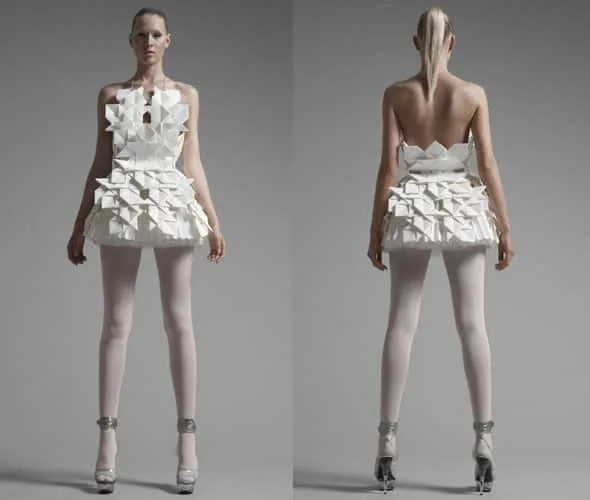
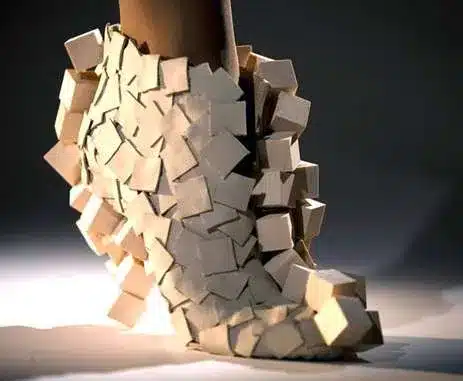
Origami’s hallmark is its use of geometric shapes, and these have been translated into fashion in a variety of ways. From the sharp, angular lines of a folded paper crane to the more complex forms of modular origami, these geometric patterns have become a source of inspiration for designers seeking to create garments that are both modern and timeless.
One designer known for incorporating origami’s geometric elements is John Galliano, who, during his time at Christian Dior, created numerous pieces that echoed the sharp angles and clean lines of origami. Galliano’s collections for Dior featured everything from dresses with dramatic, folded silhouettes to accessories like hats and bags that mimicked the crisp, precise lines of traditional origami.
The precision and simplicity of origami folds also resonate with the minimalist design trend in fashion. Origami’s clean lines and focus on structure align perfectly with minimalist principles, making it a popular source of inspiration for designers who favor a pared-down aesthetic. By focusing on form and structure rather than excess ornamentation, designers can create garments that are both visually striking and understated.
Sandra Backlund is a prime example of a designer who has embraced the minimalist potential of origami. Her collections often feature garments with simple, monochromatic color schemes, allowing the folded structure of the fabric to take center stage. Backlund’s designs demonstrate how origami can be used to create garments that are both bold and minimal, with the folds of the fabric serving as the primary design element.
Origami’s influence on fashion extends beyond structure and aesthetics; it has also impacted the way designers approach materials and construction techniques. One of the key challenges of incorporating origami into fashion is mimicking the properties of paper with fabric—creating garments that hold their shape while remaining flexible and wearable.
To achieve the crisp folds and geometric shapes characteristic of origami, designers must choose fabrics that can hold their structure. Materials like polyester taffeta, nylon, and other engineered textiles are commonly used because they can retain sharp folds without losing their shape. These fabrics allow designers to create garments that mimic the look of folded paper, but with the durability and flexibility needed for everyday wear.
In some cases, designers have even experimented with paper-like materials to create garments that are as close to actual origami as possible. One notable example is Jule Waibel, a designer who gained international attention for her origami-inspired paper dresses. Waibel’s creations, which were featured in Bershka stores worldwide, are made by hand-pleating large sheets of paper into wearable forms. Each dress takes over 10 hours to complete, demonstrating the level of craftsmanship and precision involved in translating origami into fashion design.
Another area where origami has influenced fashion design is in the realm of sustainability. Origami’s emphasis on efficiency and minimal waste has inspired designers to create zero-waste garments, where every piece of fabric is used in the construction process. This approach not only reduces material waste but also creates garments that are thoughtfully designed and constructed.
By applying origami principles to fabric cutting and garment construction, designers can create patterns that minimize waste while still producing garments that are innovative and aesthetically pleasing. This focus on sustainability is becoming increasingly important in the fashion industry, as more designers seek to reduce the environmental impact of their creations.
Over the years, several fashion designers and brands have gained recognition for their origami-inspired designs. These designers have taken the principles of origami and adapted them to create garments and accessories that are as much about art as they are about fashion.
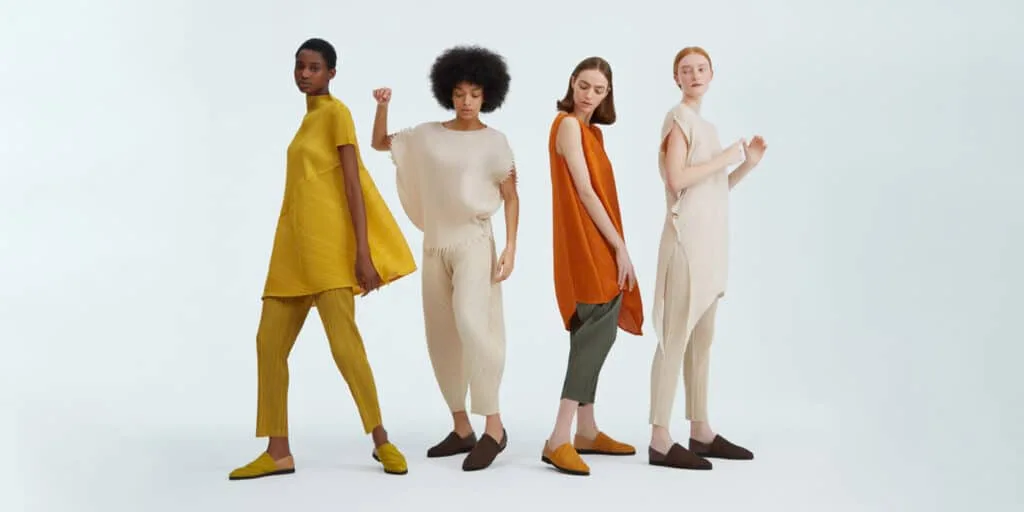
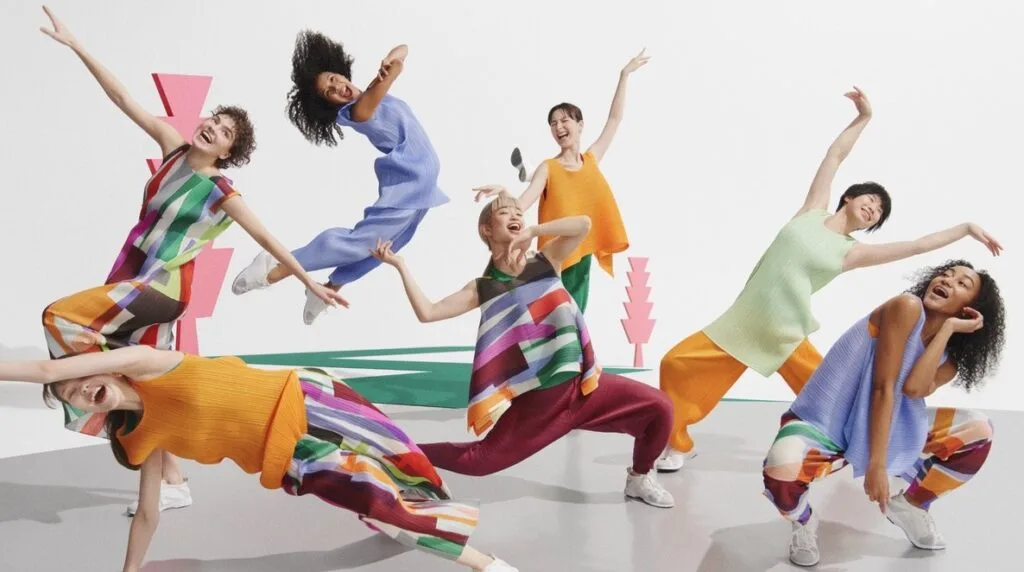
As previously mentioned, Issey Miyake is one of the pioneers of origami-inspired fashion design. His “Pleats Please” line has become iconic for its use of heat-set pleats that create structured yet flexible garments. Miyake’s work is a testament to the power of origami in fashion, blending form, function, and artistic expression into garments that are wearable and sculptural.
During his tenure at Christian Dior, John Galliano incorporated origami-inspired elements into his collections, creating dramatic pieces that featured sharp angles and intricate folds. Galliano’s work at Dior included not only dresses but also accessories like hats and bags that echoed the geometric precision of origami.
The luxury brand Marchesa has also embraced origami, producing evening gowns that feature origami-inspired pleats and folds. These gowns are known for their sculptural qualities and attention to detail, making them a popular choice for red carpet events and high-profile occasions.
Another designer known for pushing the boundaries of fashion through origami-inspired techniques is Iris van Herpen. Van Herpen’s avant-garde designs often feature intricate folding techniques and geometric patterns that challenge traditional notions of garment construction. By using cutting-edge technology like 3D printing and laser cutting, van Herpen has taken origami-inspired fashion to new levels of innovation and complexity.
From innovative pleating to the sculptural use of fabric, the influence of origami on fashion design is a testament to the boundless creativity of designers who merge art and functionality. For art collectors and interior designers, origami-inspired fashion represents the intersection of geometry, precision, and innovation—bringing art into everyday wear in unexpected and beautiful ways.